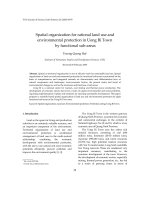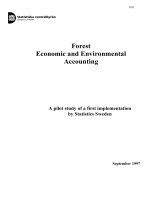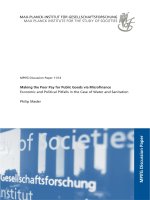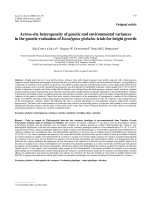Sustainable social, economic and environmental revitalization in multan city
Bạn đang xem bản rút gọn của tài liệu. Xem và tải ngay bản đầy đủ của tài liệu tại đây (12.57 MB, 301 trang )
Research for Development
Adalberto Del Bo
Daniele Fabrizio Bignami Editors
Sustainable
Social, Economic
and Environmental
Revitalization
in Multan City
A Multidisciplinary
Italian–Pakistani Project
Research for Development
Series Editors
Emilio Bartezzaghi
Giampio Bracchi
For further volumes:
/>
ThiS is a FM Blank Page
Adalberto Del Bo • Daniele Fabrizio Bignami
Editors
Sustainable Social, Economic
and Environmental
Revitalization in Multan City
A Multidisciplinary Italian–Pakistani Project
Editors
Adalberto Del Bo
Department of Architecture,
Built Environment and
Construction Engineering
Politecnico di Milano
Milan, Italy
Daniele Fabrizio Bignami
Project Development Department
Fondazione Politecnico di Milano
Milan, Italy
ISBN 978-3-319-02116-4
ISBN 978-3-319-02117-1 (eBook)
DOI 10.1007/978-3-319-02117-1
Springer Cham Heidelberg New York Dordrecht London
Library of Congress Control Number: 2013957699
© Springer International Publishing Switzerland 2014
This work is subject to copyright. All rights are reserved by the Publisher, whether the whole or part
of the material is concerned, specifically the rights of translation, reprinting, reuse of illustrations,
recitation, broadcasting, reproduction on microfilms or in any other physical way, and transmission or
information storage and retrieval, electronic adaptation, computer software, or by similar or dissimilar
methodology now known or hereafter developed. Exempted from this legal reservation are brief excerpts
in connection with reviews or scholarly analysis or material supplied specifically for the purpose of being
entered and executed on a computer system, for exclusive use by the purchaser of the work. Duplication
of this publication or parts thereof is permitted only under the provisions of the Copyright Law of the
Publisher’s location, in its current version, and permission for use must always be obtained from
Springer. Permissions for use may be obtained through RightsLink at the Copyright Clearance Center.
Violations are liable to prosecution under the respective Copyright Law.
The use of general descriptive names, registered names, trademarks, service marks, etc. in this
publication does not imply, even in the absence of a specific statement, that such names are exempt
from the relevant protective laws and regulations and therefore free for general use.
While the advice and information in this book are believed to be true and accurate at the date of
publication, neither the authors nor the editors nor the publisher can accept any legal responsibility for
any errors or omissions that may be made. The publisher makes no warranty, express or implied, with
respect to the material contained herein.
Printed on acid-free paper
Springer is part of Springer Science+Business Media (www.springer.com)
Foreword
This publication concerns studies, programmes and designs for the project Sustainable Social Economic and Environmental Revitalization in the historic core of
Multan City in Pakistani Punjab developed by Fondazione Politecnico di Milano,
an institution that cooperates with Politecnico di Milano in the research fields of
architecture, engineering and industrial design. The activities are part of the Debt
Swap Agreement signed in 2006 between the governments of Italy and Pakistan for
development in the social sectors.
The need for urgent interventions is clearly evidenced by the condition of the
Walled City of Multan. Besides its extraordinarily valuable architecture and its dense
and hard-working population, there is a physical and environmental condition that is
extremely problematic and that may threaten the continuity of life in the historic part
of a city well known for being among the world’s most ancient settlements.
The social and cultural interest and the academic challenge of a new opportunity
to deal once again with great traditions pushed Fondazione Politecnico di Milano
and the University’s researchers to face the urgency, complexity and delicacy of an
activity that will continue to be undertaken with the same determination and
passion that have so far characterised the involvement till now.
In the very short period of 6 months of the first phase, the project produced
analysis, surveys, proposals and designs in city planning, architecture and restoration related to the priorities of infrastructures, tourism and energy.
The Multan Project considers a second phase of 30 months to finalise and
implement its activities and works.
In these fields worked more than 70 researchers (teachers at different degrees,
doctoral students and collaborators from five Politecnico di Milano departments,
from Fondazione Politecnico and from other external organisms), divided into
14 working groups, authors of the reports here collected.
The needs to improve livelihood and living conditions and to revitalise the
physical assets of value of the Walled City concern competences related to:
economy (micro-credit and business relationships), tourism, capacity building,
communication (Web site, publications and exhibitions), industrial design (textiles,
fashion and ceramics), satellite analysis and mapping (remote sensing), direct relief
v
vi
Foreword
and techniques of three-dimensional survey (laser-scanner), monitoring and air
quality studies, energy (relatively to the cities and buildings), urban infrastructure
system (collection, distribution, water quality, sewer and electric), studies and
proposals on traffic, restoration, conservation and architectural and urban design.
From the atmospheres of Multan (photo by Marco Introini)
Adalberto Del Bo
Department of Architecture
Built Environment and Construction Engineering
Politecnico di Milano
Milan, Italy
Daniele F. Bignami
Project Development Department
Fondazione Politecnico di Milano
Milan, Italy
Overture
There is no doubt that Pakistan is a land of heritage and strong tradition; a place of
fascination and interest; and a crossroad between culture and politics, history and
renewal, past and future. This book is the result of an extraordinary, unique, and
extended project encompassing a great variety of subjects, such as urban planning,
architectural conservation and infrastructure, economic development and capacity
building. “Sustainable Social Economic and Environmental Revitalization in the
Historic Core of Multan City” is an ongoing dialogue and a new perspective to
forge stronger relationships between Italy and Pakistan.
Fondazione Politecnico di Milano is proud to have been responsible for a
cooperation agreement between the Italian Government and the Republic of Pakistan, something that is first and foremost inseparable from the passionate and
unanimous commitment of approximately 70 researchers and professors from our
university. One hundred and fifty years after its birth, the Politecnico di Milano is
now an international organisation that speaks the languages of universal challenges
that understand and interpret the demands of regions having different traditions,
culture and needs.
We would like to express our special thanks to the Bahauddin Zakariya University, a vitally important academic partner, the local institutions and the Italian
Embassy for their valuable cooperation and support.
Milan, Italy
Giampio Bracchi
President of Fondazione Politecnico di Milano
vii
ThiS is a FM Blank Page
Preface
This book illustrates the complex work carried out by Politecnico di Milano,
highlighting Italian excellence around the world and the important role played by
our country and its leading experts in places that are geographically far but very
close in terms of their historical and cultural connections. For thousands of years
Multan has been an important caravan and trading city situated on a major trade
route. On the basis of an ancient tradition, this is also the place where Alexander the
Great died and where some of the main Sufi saints came from. Such figures
highlight how Multan was once and continues to be a bridge between the Western
world and the Islamic world and between Asia and Europe.
The Italian cooperation project to restore part of the old town centre of this
ancient city was first launched in 2012 as part of the Pakistani–Italian bilateral debtfor-development conversion scheme and takes major action to protect the artistic
and historical heritage of one of the most fascinating urban fabrics in Pakistan and,
perhaps of, all Central Asia. Presented as a platform for the economic relaunch of
the area, the project’s main goal is the social and environmental redevelopment of
spaces and buildings that have been left abandoned for many years, plus an
improvement in the health conditions and quality of life for the many thousands
of people living and working in the “walled city”. The project is also important for
the process of identity building of those living in Multan as, with over 70 % of the
local population under the age of 30, it enables new generations to rediscover their
past and build their future using these origins as a starting point.
Italy therefore paves the way with a large-scale project that encompasses
technical and scientific analysis, architectural restoration, capacity building and
fight against poverty, by safeguarding ancient trades and protecting the environment and human health. It is hoped that in the future this innovative idea may act as
a model for other similar projects carried out by other stakeholders to ensure
propitious restoration of the entire old city of Multan and to protect a rapidly
declining legacy that could otherwise disappear completely over the course of a
few years, victim of an advanced state of neglect and of new construction procedures that pay little attention to the original fragile urban fabric.
ix
x
Preface
This book illustrates how in the first stage, with ongoing support from the
Embassy in Islamabad, Politecnico of Milano played a key role not only in carrying
out vital activities such as mapping, surveying and planning, but also in acting as a
“steering committee” to help drive the project on and facilitate the often difficult
interaction between the many figures and various administrative levels involved.
I would like to pay my compliments to Fondazione Politecnico di Milano and the
team of researchers, technicians and experts of Politecnico di Milano, led by
Professor Adalberto del Bo, who have done a commendable job in the key sector
of artistic and historical heritage protection. The work performed by Politecnico di
Milano honours Italian tradition in this sector and links its name to a project that
will be of very significant importance to Pakistan and the region.
Islamabad, Pakistan
30 July 2013
Adriano Chiodi Cianfarani
Italian Ambassador to Pakistan
Messages to the Multan Walled City Project
Vincenzo Prati
Italian Ambassador to Pakistan (2008–2012)
I believe the partnership between the Politecnico di Milano and the Bahauddin
Zakariya University in Multan to be one of the most important initiatives undertaken during my time as Italian Ambassador to Pakistan, and I am delighted that
Ambassador Chiodi has continued to support it with similar interest. The projects
on display in this book bear witness to the contribution that such a partnership can
have in transforming the appearance of a part of the historic centre of the City of
Saints. But if this were the only impact, it would not be worthy of our enthusiasm;
our enthusiasm is the result of the idea that two major university institutions were
able to decide to commit to an important project for the future and to provide a
developmental framework for other increasingly important initiatives. It is with this
in mind that we must try to look beyond and formalise the idea of regular
internationally significant seminars focusing on important global issues. I have
been given the opportunity to bring hope for an economic and cultural recovery
to my friends in Pakistan, for a conquering of that inspirational leadership role that a
great country such as Pakistan deserves.
Kamran Lashari
Secretary, Ministry of Housing and Works, Islamabad, Pakistan
I feel privileged to be associated with the Project of Sustainable Social, Economic
and Environmental Revitalization for the historic core of Multan City. Though I
was all along based in Islamabad, I was interacting with the Italian team and the
local administration on various occasions. The project has yet to take a practical
shape, i.e. rehabilitation work hasn’t begun; the work that has gone into planning
and preparation is quite admirable. The detail surveys and documentations for
Multan old city carried out by the Italian team is an asset.
Under the leadership of Professor Dr. Adalberto Del Bo, the Italian team has
made a number of visits to the Walled City in the scorching heat of Multan. There
has been a great commitment and dedication by the polytechnical school of Milano.
xi
xii
Messages to the Multan Walled City Project
I am very glad to note that the entire experience and effort, studies and surveys
are documented in the shape of book. This book covers a wide range of subjects and
shall be a very useful document to read and also use for the sake of reference for the
living cultural and heritage of Multan. My compliments to the Italian team for this
wonderful production.
06 August 2013
Gulzar Shah
Multan District Coordinator Officer—Multan Walled City Project Director,
Multan, Pakistan
Bearing in mind the poor living conditions of the old city of Multan, Fondazione
Politecnico di Milano’s initiative, in the framework of Pakistan Italian Debt Swap
Agreement and of Pakistani-Italian Development co-operation, has been important
in addressing issues faced by local people towards living and social improvement.
Among the different issues that were covered, Fondazione Politecnico di
Milano’s concerns for microcredit, handicraft, air quality, water and sanitation
system are of primary importance for the Walled City inhabitants.
We are highly thankful to the Italian Embassy and to Fondazione Politecnico di
Milano for considering the significance and value of the old historic core of Multan
Walled City.
We have also appreciated the commitment and expertise of Mr. Juan Xabier
Monjas Kanpandegi, the Multan Walled City Project Director Resident Representative of Fondazione Politecnico di Milano, in managing the project.
30 July 2013
I Should Have Known Better: Anecdotal
Remarks on the Sustainability of the Multan’s
Core City Project
Merveilleuse dernie`re sce`ne de Jurassic Park, ou les ne´o-dinosaures clone´s de´vastent le
muse´e et font un carnage de leurs anceˆtres fossiles – une assez bonne anticipation de notre
espe`ce, coince´e entre ses fossiles et ses clones. Le proble`me de l’espe`ce humaine, c’est que
c¸a commence a` eˆtre du de´ja` vu, meˆme a ses propres yeux. Etant donne sa maitrise virtuelle
du monde et son succe`s total (?) en tant qu’espe`ce, ce n’est plus son e´volution, c’est sa
disparition qui devient inte´ressante.
Jean Baudrillard – Fragments – Cool Memories III 1991–1995
Introduction and Background
The last memory of an institutional mission carried out in the ancient Multan
Walled City (Punjab, Pakistan) is about a conversation, walking through the narrow
way leading to the City core.1 The subject was the activity being carried out in the
heritage and local development project, sponsored by the Pakistan–Italy Debt-Swap
Agreement (PIDSA) program, a multi-sector, nationwide debt-for development
undertaking for heritage conservation, training and community-building activities
in the Multan ancient city.
The matter of that conversation shifted from technical issues to the language that
was spoken amongst the group, that sunny and dusty early morning, in the narrow
streets of that impressive bricked ancient town. This was raised by a young project
officer of the local project management unit (PMU) who was underlying that it was
inappropriate having to listen to a dialogue in Italian, as not everybody could
understand. The topic was actually well taken and inspired us to wonder about
how many times stakeholders and professionals working people in this ambitious
undertaking could not understand each other or more precisely otherwise what was
the matter being discussed.
1
Overseas Technical Unit & Pakistan-Italy Debt Swap Agreement (TSU) field trip in Multan,
11/2012.
xiii
xiv
I Should Have Known Better
The Project Area
Multan is believed to be amongst the oldest Asian towns and actually one of the
most ancient inhabited places in the world. Through history, the area was ruled and
visited by many, including Alexander the Great, the Arabs, the Turks, the Sikhs and
eventually by the British, the last starting from the first-half of the seventeenth
century. The walled city, whose origins appear confused in a distant past and are
hardly known, is somewhat mysterious. Multan has been an important centre in the
ancient past and during the middle age, and it was certainly one of the early and
most important Punjabi cities of commercial interactions with Europe, and a
flourishing site of crossing cultures from Central Asia, India, Europe and other
major influences. It is remarkable that it is illustrated and indicated as a main city of
ancient Asia in the renowned geographical frescos and Mappa Mundi of the
Farnese Palace in Caprarola (Italy),2 a remarkable example of Italian Mannerism
and Renaissance architecture, where the city of Multan emerges, in the fourteenth
century (1574) in the Room of the World Map, as an outstanding centre enlightened
with power, beauty and economic importance reflected over the whole sub-region.
The Farnese Mansion (Caprarola, Italy) [Engraving of the Palazzo Farnese a Caprarola, possibly
of the second-half of seventeenth century (© Domenico Bruzzone)]
Multan passed through several times of wealth, power and decay, and its former
importance seems to have been just perceived by some of the British Officers when
attempting its seizing. John Jones Cole opens his account on the siege of the city
2
Adalberto Del Bo, Politecnico di Milano (see Chap. 1).
I Should Have Known Better
xv
telling us: ...(Mooltan). . .‘It is a very important, and strongly fortified place, and
second only to Lahore in extent of trade, and number of its inhabitants. It is said to
contain ten thousand houses, which are for the most part built of brick, and many of
them two or three stories high; some of them contain good and airy rooms, and are
capable of being made habitable for Europeans. As in native cities generally, there
are many squalid hovels, close ill-ventilated holes, wherein the very poorest classes
live. The streets are indirect, narrow, badly paved and dirty. The inhabitants
(Hindoos, Sikhs and Mussulmans) are estimated at 50,000. They carry on a brisk
trade amongst themselves, and have large and well-furnished bazaars. They also
barter extensively in silks and cotton goods with the inhabitants of the adjacent
countries. The town is surrounded on three sides by a high and well-built brickwall, strengthened at short distances by semicircular bastions, and it has five
covered and well-defended gateways. On the fourth, or north-western side it is
bounded by the fort itself, at the foot of the glacis of which it terminates. . .(. . .). . .3
Scene in the Multan City centre in 2012
The research work, carried out by the Fondazione Politecnico di Milano, as
Consultant to the Pakistani Ministry of Housing & Works (the Executing Agency) in
Multan (2011–2013) produced a commendable project planning exercise, in the
form of a First Phase report. This is encompassing a number of urban planning
studies, advanced field surveys—carried out in the Multan walled city, and in the
surrounding areas—a training-on-the job program that involved the Project Management Unit (PMU) on site, and a series of specific applied research trials. All
3
A sketch of the siege of Mooltan (1849) first print by P.S. D’Rozario and Co. Tank-Square, Sange-Meel Publications, Lahore, 1999, John Jones Cole.
xvi
I Should Have Known Better
these technical activities were conducive to the design of a subsequent phase, in the
form of an action ‘Project second phase’, whose blueprint is currently being
considered by both local and federal authorities for possible financing.
The viability of carrying out the second phase of this project is being thoroughly
appraised by the Pakistan–Italy Debt-Swap Management Committee4 (09/13). The
scrutiny does not concern the quality of the first phase output results, but the risks
inherent with some of the project assumptions. Indeed, it is an ambitious and
complex multi-tasking framework of activities, aiming at gathering investments
to support Multan’s Core City in a threefold dimension, heritage, economic and
societal, by applying the aforementioned research findings and planning tools to the
City Core as a unitary framework. The aim of this note is to show how easily prime
operational research, institutional efforts and sound policy dialogue can be frustrated by factors that were possibly not intercepted while appraising the project
during the identification phase, nor were they subsequently redeemed, most likely
because of the complexity of technical activities that drained all energies and
attention devoted to the project, leaving little room to focusing to the big picture
of this undertaking. Other troubles may have been raised by limits in day by day
technical communication and some bewilderment regarding roles and functions at
the project management level, possibly born out of semantics factors obscuring
technical dialogue.
Sustainability: A Science, and the Ability of Managing
Process-Complexity
There are many uses of the term sustainability. When associated to the concept of
development in what Herman Daly defined an oxymoron,5 it is the result of
thinking about the global carrying capacity of the planets’ natural resources base
in its contemporary utilization and transformation into goods and services by
human societies. This vision was first stirred by works of Vitousek6 and their
ensuing elaboration by development economists.
In aid practice, the day by day meaning of the term sustainability is perhaps less
sophisticated and refers more to the project logic underpinning technical activities
and to the complications that invariably arise from a number of factors.7 These
encompass from limits of the project appraisal phase to scientific, technical,
4
The project is part of the Pakistan-Italy Debt-Swap Agreement (PIDSA), a nation-wide, comprehensive, multi-sector program whose execution started in 2006.
5
Sustainable Growth: An Impossibility Theorem, In: Valuing the earth: Economics, Ecology,
Ethics—Herman E. Daly and Kenneth N. Townsend (1993).
6
Human Appropriation of the Products of Photosynthesis—Peter M. Vitousek; Paul R. Ehrlich;
Anne H. Ehrlich; Pamela A. Matson—Bioscience, Vol. 36, No. 6. (Jun., 1986), pp. 368–373.
7
These assumptions should be thoroughly appraised and controlled during the process of project
identification and formulation, although experience demonstrates that in a number of cases this is
the most vulnerable element managed throughout the process of project cycle management.
I Should Have Known Better
xvii
process-related or institutional elements that may remain hidden in the context, to
disclose unexpectedly. Hampering factors are fairly common, and a number of
specific toolkits were developed at both the technical and institutional level,8 to
assist their identification and control.
At the time this note is written, the institutional dialogue about its future is about
the risks that are inherent to the second phase, under the current circumstances.
Most likely, these risks derive from an insufficient analysis of the initial assumptions that are causing the stalling of project cycle and a number of problems to
disclose; amongst others are the following:
• At the technical level. These are mostly management-related, being difficulties
that raised from interactions with the PMU in Multan. These were apparently
instigated by different judgements of specific technical matters but revealed later
to be caused rather by different interpretations of roles and (therefore) of policy
priorities. Indeed, at a time, it was most evident that there were tangible
differences and discrepancies in interpreting the institutional role of each
Party, with the PMU supervising technical activities rather than embracing and
facilitating them proactively, or otherwise with the PMU debating the scope of
the Consultant’s work, instead of its final output product. To a certain extent this
can be explained with the fact that simplifying tasks and adopting a commandand-control approach appears easier than scrutinizing complex set-ups of technical information. Eventually, we collected enough indications that supported
the existence of a genuine misplaced objective in PMU’s daily assessments.9
• At the institutional level. Local authorities, often pressed by daily quandaries,
appeared to be reasonably puzzled with these ambiguities and were themselves
somehow trapped between a supportive or a command-and-control approach to
this complex scheme. This reflected the confusion of the situation. It cannot be
ignored that institutional communication ambiguities tend to play a role in
articulated programmes. Moreover, the executing agency did not appear to be
in the position to perform at the required level, possibly because of the limitations of its institutional mandate.
• At the community and professional associations level. The situation was not
easier while elaborating with local communities, during a series of interviews,
on projects strengths and weaknesses. Multan City Core dwellers tended to
overemphasize roles and responsibilities at the institutional level and showed
an inclination to adopt some of the project functions as an opportunity to express
frustration and scepticism on local public policies. This is another fact that is not
uncommon in these cases. Most important, while they were constantly consulted
by the Fondazione Politecnico at the survey level, they appeared weakly incorporated within the framework of project activities. This is because they had
basically no active role. This fact was adding to the challenges, especially
8
The Integrated approach to project cycle management—Hellmut Eggers, In: Project Appraisal,
Volume 7, Number 1, March 1992, pages 3–10, Beech Tree Publishing.
9
See January 2013 Technical Report, 12/2012 Consultancy to Ministry of Foreign Affairs, Rome
(internal note).
xviii
I Should Have Known Better
considering the societal project ambition. It is worth to mention here the
partnership established between the Fondazione Politecnico and the Zakaria
University in Multan, that lead to involve the institution as well as students and
teachers to support activities like survey and communication, facilitating the
acquaintance and dialogue with the local community.
In this burdensome situation, one of the most striking observation (and contribution) was made by the interim Economic Affairs Division Secretary10at the time
of presenting the results of Phase I. It was related to the project’s institutional
architecture, and it was expressed with the simplest possible statement on its very
concept: ‘this institutional set-up may well make this project unsustainable’. This
consideration was referred to the role of the executing agency, in authority for
public works and housing issues, rather than for heritage matters. These, in turn, do
have still a reduced track record in Pakistan, the fact which is perhaps also in
coherence with a tourist sector that still is by far the least developed in the
sub-region.11 Something, everybody should have known better, most likely. This
is certainly not all, but we believe it is informative. It must, however, be stressed
that the project was not appraised as a heritage thematic undertaking, but rather as a
socio-economic development investment, run with a major heritage focus. This
implies skills, expertise and a regulatory mechanism that is barely yet functionally
developed in the country. The only similar pilot project, the so-called Walled City of
Lahore, sponsored by the World Bank and the Punjab Government, has identified a
mechanism of a specific authority12 to it, after several years of implementation, and
a similar scheme could be applied as well in Multan, in the framework of the
possible execution phase.
Lessons for Project Logic
These issues confirm that development projects—that could be defined as a blend of
maximum intellectual creativity with maximum technical strictness—are by far
more intricate than what usually perceived from their logframes or blueprints.
Often, they tend to be assumed following different interpretation paths and by
diverging observatories by the same stakeholders. More important, the inherent
complexity and the content of knowledge and technology they convey as valueadded of their own to the Beneficiary can often be hindered by very meek or
marginal causes, even hidden in elementary management feebleness.13
10
Economic Affairs Division, Paris Club Section, Islamabad, 05/2013.
Development challenges confronting Pakistan, Anita M. Weiss and Saba Gul Khattak (Ed.),
Boulder & London, 2013.
12
Internet source: Walled City of Lahore Authority Walled City Lahore GOP; http://www.
walledcitylahore.gop.pk/2013
13
As an example for this recurrent issue: ‘Process-control: an untapped resources for managers of
SIT programs’ H. Lorraine & D. Bruzzone—Technological forecast and Social Change, 1991.
11
I Should Have Known Better
xix
If approved, the project second phase should thus continue addressing a number
of delicate and multifaceted matters such as inter alia:
• The importance and scoping of heritage financing14 in social contexts that face
primary and urgent needs
• The technical and institutional specificities of financing heritage project, their
project cycle and social participation needs
• The participatory dimension to be associated at early stages of project planning
and implementation
• The legal and institutional toolkit necessary for their implementation and
administration
At the time this note is written, the opportunity for investing further resources in
support of the Multan Project Second Phase is still under consideration, together
with the need of preserving the beauty of the City work of genius.
As far as financing is considered, both interested parties confirmed the importance and urgency to preserve the much threatened Multan’s heritage, its inherent
values and their societal significance. However, the role of all involved institutional
subjects will need serious reconsideration and further scrutiny. The project blueprint will necessitate upgrade and amendments accordingly.
To a certain extent, this is also to say agreeing upon how much Italian or Urdu
will be spoken.
. . .(. . .). . .Thus, Oriental languages are part of some policy objective—as to a certain extent
they have always been - or part of a sustained propaganda effort. In both these aims the
study of Oriental languages becomes the instrument carrying out Harold Lasswell’s theses
about propaganda, in which what counts is not what people are or think, but what they can
be made to be or think.
. . .(. . .). . . The acquired foreign language is therefore made part of a subtle assault upon
populations, just as the study of a foreign region like the Orient is turned into a program for
control by divination.
Edward W. Said – Orientalism
Islamabad, Pakistan
Domenico Bruzzone
Director, Overseas Technical Unit, Pakistan Operations.
Embassy of Italy to Pakistan
Marco Marchetti
Consultant – Former Co-Director,
Pakistan-Italy Debt-SwapAgreement (PIDSA)
Ali Raza Bhutta
Joint Secretary (Paris Club) – Economic Affairs Division – Ministry
of Finance (Islamabad)
14
For a comprehensive review of these matters from an epistemological and political viewpoint,
see: Salvatore Settis ‘Paesaggio, Costituzione Cemento’ pp. VIII—328, 2012, Einaudi, Torino,
ISBN 9788858406755.
ThiS is a FM Blank Page
Acknowledgements
The work on Multan Walled City (MWC) project involves the skills and competencies of numerous individuals, institutions and organisations.
Initially we desire to underline that the MWC project would not have been possible
without the strength and determination of Ion Xabier Monjas Kanpandegi, the Project
Director Resident Representative. “Xabi” has proved all his ability on the ground; the
editors take this opportunity to gratefully thank the support and the solutions offered
by him to all the rest of the MWC team. With him Daniele Beacco, spending 6 months
in Pakistan, has contributed in giving certainty to our operations on the Walled City.
Fondazione Politecnico di Milano is grateful to the persons, the institutions and
the organisations listed below for their contributions and supports to the activities:
• The Ministry of Housing and Works of the Islamic Republic of Pakistan
• The Ministry of Economic Affairs—Economic Affairs Division (EAD)—of the
Islamic Republic of Pakistan
• Planning Commission—Government of Pakistan
• The Management Committee and the Technical Support Unit (TSU) of the
Pakistani–Italian Debt Swap Counterpart Fund
• Bahauddin Zakariya University (BZU) of Multan
• The Consulate of the Islamic Republic of Pakistan in Milan
• Multan Police, Elite, Special Branch
• Punjab Small Industries Corporation
• The Italian Ministry of Foreign Affairs of Italy (MAE)—Directorate General for
Development Cooperation (DGCS)
• The Embassy of Italy in Pakistan
• Mr. Adriano Chiodi Cianfarani Ambassador of Italy in Pakistan
• Mr. Vincenzo Prati, Ambassador of Italy in Pakistan (2008–2012)
• Mrs. Sara Rezoagli, Embassy of Italy
• Mr. Federico Bianchi, Embassy of Italy
• Mr. Domenico Bruzzone, Director, Overseas Technical Unit (UTL) in Pakistan
Italian Embassy
• Mr. Kamran Lashari, Secretary Ministry of Housing and Works
xxi
xxii
•
•
•
•
•
•
•
•
•
•
•
•
Acknowledgements
Mr. Ali Zahid, General Consul of Islamic Republic of Pakistan in Italy
Mr. Muhammad Khurram Agha, Commissioner Multan Division
The Vice Chancellor Syed Khawaja Alqama of BZU Multan
Prof. Muhammad Ali, Registrar, Prof. Zafar Haider Gilani and Prof. Tahir Said
Bappi of BZU
Mrs. Ammarah Manzoor Khan, Punjab Small Industries Corporation
Prof. Arch. Masood Khan and Aga Khan Trust for Culture
Mr. Luigi Damiani, Italian Codirector Technical Support Unit (TSU)
Pakistani–Italian Debt Swap Agreement (PIDSA)
Mr. Marco Marchetti, Ex-Italian Codirector Technical Support Unit (TSU)
Pakistani–Italian Debt Swap Agreement (PIDSA)
Mr. Ruggiero Ludovici—MAE Consultant
The Italian companies Mountain Equipe and MMI
Engineers Without Borders, Milan
GECO - Laboratorio di Geomatica per la Conservazione e la Comunicazione dei
Beni Culturali, Universita` degli Studi di Firenze
Prof. Adalberto Del Bo exposing to the Ambassador Vincenzo Prati and the Vice Chancellor Prof.
Dr. Syed Khawaja Alqama the strategies of the MWC project during the exhibition “Heritage and
Beauty” at the temporary Pakistani–Italian Resource Centre at the BZU Campus
We wish also to express appreciation to the MWC Project Management Unit for
discussion and communications on the intermediate reports on the works:
•
•
•
•
Mr. Gulzar Shah, MWC Project Director and DCO Multan
Mr. Naseem Sadiq, Ex-MWC Project Director and DCO Multan
Mr. Zahid Zaman, Ex-MWC Project Director and DCO Multan
Mr. Jamshaid Alam, Mr. Adnan Arshad Aulakh, Mr. Sarfraz Khan Magsi,
Mr. Ahmend Nadeem Khan, Mr. Rashid Shoaib, Ms. Zoobia Arif, Mr. Abdul
Samad and Mr. Aziz Ur Rehman of the MWC Project Management Unit
• Mr. Javed Iqbal (EDO) F & P
Acknowledgements
xxiii
Finally we would like to offer a special thanks to the following:
• City District Government (WASA, Multan Development Authority, Solid Waste
Management)
• Town Management Authority
• Akhuwat
• Auqaf and Religious Affairs
• Aga Khan Cultural Services—Pakistan (AKCS-P)
• Director Development Pakistani Public Works
• Multan Electric Power Company (MEPCO)
• Pakistan Tourism Development Corporation (PTDC)
• Government of Punjab (Directorate of Archaeology)
• TEVTA (Institute of Blue Pottery Development, Ministry of Production (SPEI))
• NFC Institute of Engineering and Technological Training
• Multan Chamber of Commerce
• Multan Crafts Bazar
• Italian Pakistan Business Association
• All the people in Multan
Ion Xabier Monjas Kanpandegi, Multan Walled City Project Director Resident Representative (the
third from the left); Eugenio Gatti, General Director of the Fondazione Politecnico di Milano
(kneeling on the left); and people of the MWC team, at the end of the preparation of the exhibition
Heritage and Beauty at the temporary Pakistani–Italian Resource Centre at the BZU Campus in
Multan with our friends of Elite Punjab Police and of BZU
We also acknowledge the assistance of the following Fondazione Politecnico di
Milano staff, who have contributed to the development of the project, operating in
Italy: Matteo Bogana, Alessio Campi, Enza Caputo, Luca Di Natale, Mario Foti,
Maria Francolino, Mariangela Gobbi, Federica Lamberti, Monica Lancini,
Emanuela Murari, Sonia Pezzali, Carmela Santagati, Paolo Scacchi, Elena Sicurella
and Alfredo Valtolina.
ThiS is a FM Blank Page









